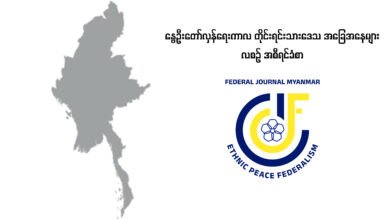
The situation of the Spring Revolution in Ethnic Areas
(November 2022 – January 2023)
The Federal Journal-Myanmar collects and publishes monthly public activities, movements, and coordination in resisting the military junta during the Spring Revolution period in Myanmar. By this time, the report focused on the political dynamic and conflict development within the past three months by examining casualties on both sides (military junta and resisting groups) due to conflict incidents, destruction of civilian structures due to the Junta’s operation, and administrative or political coordination bodies in Ethnic areas from November 2022 to January 2023.
Part (1)
The military and security situation in Ethnic Areas
- Armed Clashes and casualties on both sides
In the past three months from November 2022 to January 2023, a total of 850 small and large scales armed clash incidences occurred between the SAC’s troops and resistant forces; about 650 times in Karen state, at least 11 times in Kachin state, at least 38 times in Chin state, at least 84 times in Karenni state, at least 35 times in Shan state and 38 times in Mon state respectively.
In that period, more than 1000 troops of SAC were killed in clashes by the resistant group in ethnic areas. The highest and second highest numbers of killing the junta troops were seen in Karen and Chin states with 600 and 120 respectively. Additionally, the killing of Junta’s troops was also observed in other states; at least 52 in Kachin, about 83 in Karenni state, at least 100 in Shan state, and 92 in Mon state respectively. From the side of resistant groups, a total of 80 freedom fighters was fallen in clashes in these three months, 40 of them were in the Karen state the highest numbers.
(Note – This time, some data from Kachin state are unavailable to access)
- Civilian Casualties and Injuries
In looking at civilian casualties, due to indiscriminate artillery shelling of the junta’s forces, the explosion of landmines,s and military clashes between the junta’s troops and resistant forces, it has been observed that at least 100 civilians lost their lives and about 230 got wounded in the reporting period. Karen again stood for the highest number of civilian casualties with 29, followed by 12 in Karenni, 10 in Shan, 9 in Kachin, 8 in Chin, and 4 on Mon respectively.
- Destruction of Civilians’ houses
In the reporting period, a total of 470 civilians’ own houses and buildings were damaged due to intentional setting on fire by Junta troops and indiscriminate shelling. Destruction of civilian structures was seen in more than 190 in Karen, 130 in Karenni, 90 in Shan, 13 in Chin, 21 in Rakhine, and 6 in Kachin respectively.
Part (II)
The activities of State and Ethnic Councils and Committees
- Pa-O National Federal Council (PNFC)
Pa-O National Federal Council – PNFC has formed three additional departments; political, military, and management. Among them, the military department supports two resistant groups known as Pa-O People Defense Force – Kham Dom – PPDF and another PaO PDF – Kham Kawng which have been taking part in Spring Revolution in resisting the military junta movement. It is learned that the term Kham Dom means plain areas whereas Kham Kawng means hill areas. These groups have three operational units; Operational unit (1) is in the Tathon area, Operational unit (2) is in the PhaAn area, and Operational unit (3) is in the border area of Shan and Karenni states. It is observed that the command and control for the operational unit (1) and (2) are coordinating with Karen National Liberation Army – KNLA and operational unit (3) is along with command and control under Karenni Army – KA.
- Mon State Interim Coordination Committee – MSICC
Mon State Federal Council (MSDC) was formed by Mon State Interim Coordination Committee – MSICC in January 2023 in order to emerge a federal unit that represents the Mon people. It is also learned that MSDC is a comprised council of eleven stakeholders which included other ethnic groups in Mon state representation apart from Mon people.
The first conference of MSFC was held on January 22, 2023, in which 86 representatives from resistant groups, women and youth groups, diaspora Mon, Pa-Oo in Mon state, and so on. The conference discussed and confirmed three main agendas; approving an interim constitution that coordinates the stakeholders who resist the junta and political roadmap in the revolution period, the formation of representatives to work on power sharing among executive, legislative, and judiciary branches in the revolution and interim period and the formation of Mon State Federal Council by 25 members to extend self-determination.
A spoke person said to the Federal Journal -Myanmar, “we are working to form an interim Mon state government. We know that there are some organizations that needed to take part in our journey”.
(C) Karenni State Consultative Council – KSCC
The first conference of the Karenni State Consultative Council – KSCC was conducted from January 17 to 20 in 2023. It is learned that the conference approved reporting of KSCC, future action plans, and elected Executive members and KSCC members.
Moreover, KSCC was reformed and stakeholders that joined in a new KSCC vowed and signed to resist the military junta from various angles; militarily, politically, and diplomatically through collective leadership. The organizations that signed as members of KSCC were the Karenni National Progressive Party – KNPP, Karenni National Defense Force – KNDF, Karenni State Interim Legislative Body, Karenni State Women Force, Karenni State Youths Forces, and Karenni state CSOs. It is also learned that the Conference also agreed to set an action plan, objectives, and basic principles and implement them to emerge Interim Karenni State Government.
References –
- Independent domestic medias,
- National Unity Government,
- Interim State Consultative Councils,
- Ethnic Human Rights Organizations,
- Interviews and data compilation of the Federal Journal – Myanmar
Compiled by the Federal Journal-Myanmar
——၀၀၀——-




